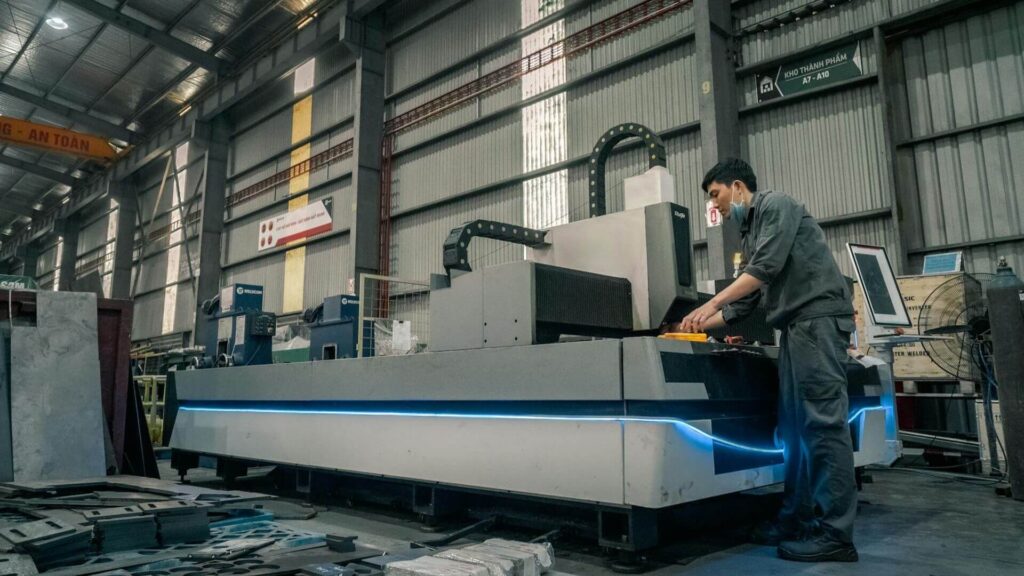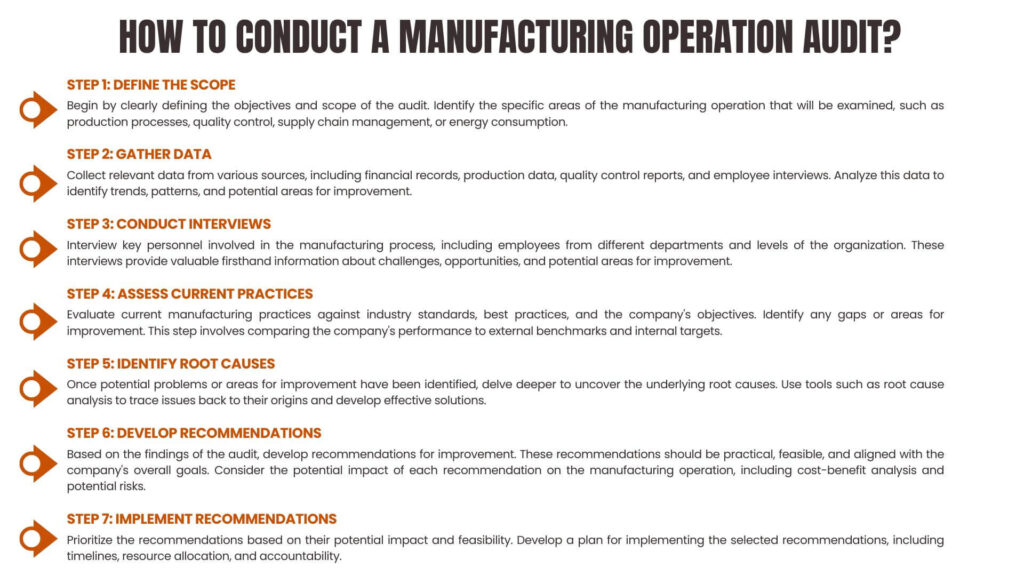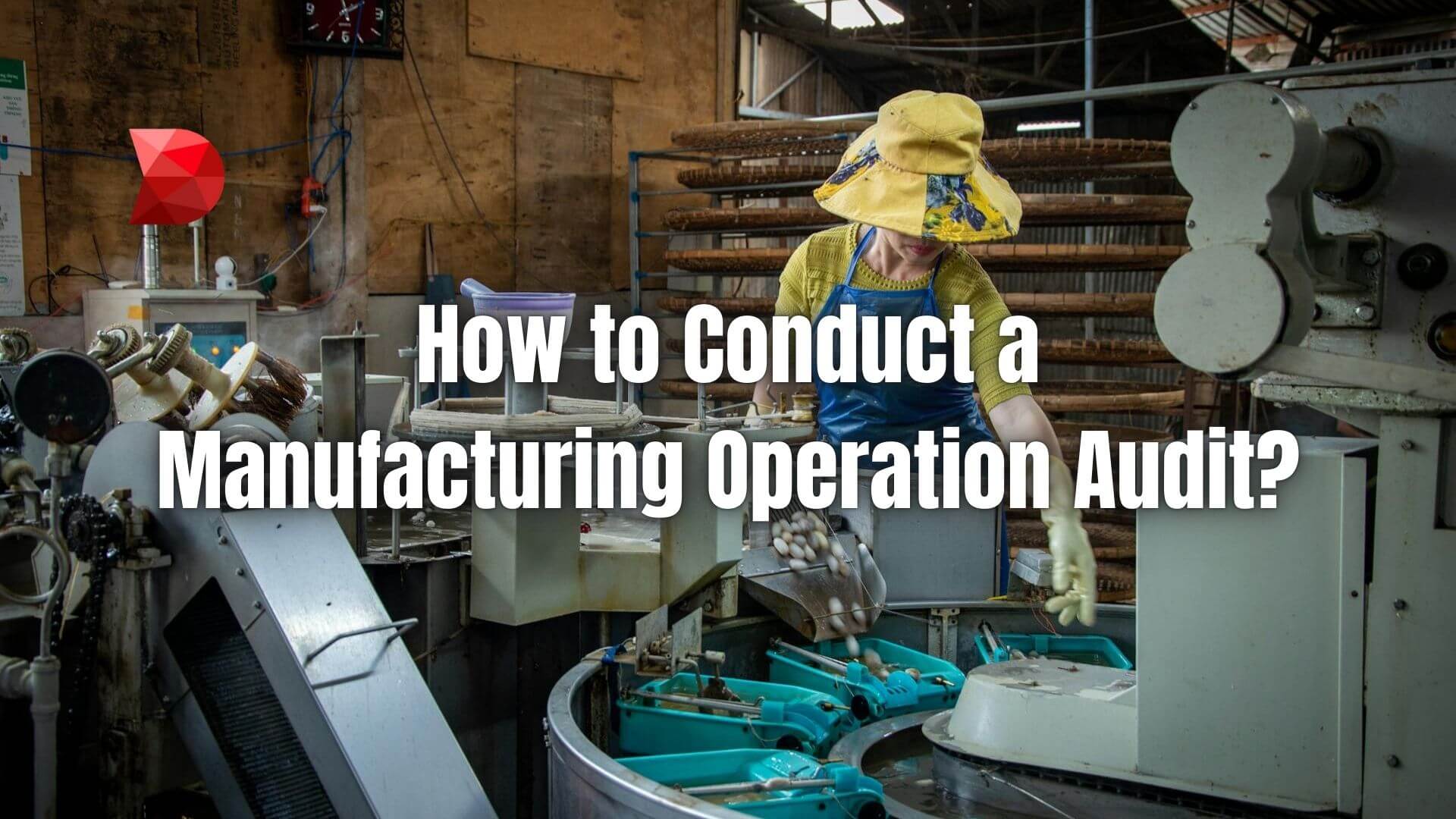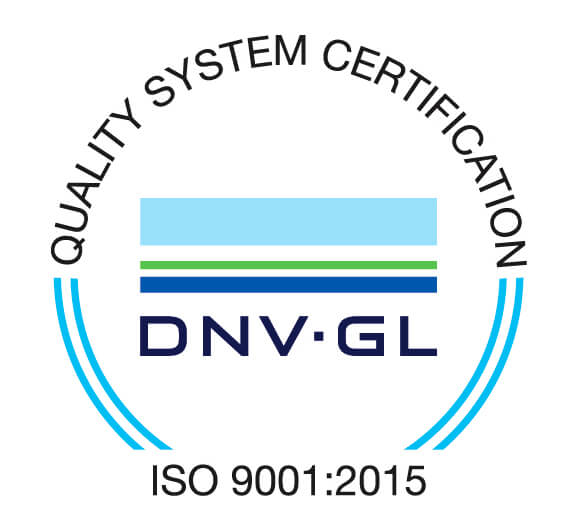Manufacturing operation audits are an essential part of manufacturing quality assurance. They provide a comprehensive view of the manufacturing process and ensure that all processes, procedures, and materials used in production are up to standard and meet customer requirements.
It is designed to assess the effectiveness of a manufacturing process from incoming material through every single stage, including material handling and in-process quality control. This guide will cover a manufacturing operation audit, how it works, why manufacturers must conduct one regularly, and the best practices for executing such an audit.
Table of Contents
ToggleWhat is a Manufacturing Operation Audit?

A manufacturing operation audit is a systematic examination of a manufacturing company’s processes to assess their effectiveness and identify areas for improvement. It involves a detailed evaluation of various aspects of the manufacturing operation, including production processes, quality control procedures, supply chain management, and other critical functions.
By conducting a thorough audit, companies can gain valuable insights into their operations, identify inefficiencies, and implement strategies to optimize performance. This can lead to cost reductions, improved quality, increased productivity, and enhanced overall competitiveness.
Purpose of a Manufacturing Operation Audit
A manufacturing operation audit serves as a critical tool for businesses to identify areas for improvement, enhance efficiency, and reduce waste within their manufacturing processes. By conducting a comprehensive evaluation, companies can gain valuable insights into their operations, optimize performance, and ultimately achieve their strategic objectives.
The audit typically involves a detailed review of key manufacturing metrics, including production defects, output rates, and downtime. This data-driven approach allows for the identification of bottlenecks, inefficiencies, and areas for improvement.
To gather the necessary information, a dedicated team of auditors conducts a thorough examination of the manufacturing operation. This process involves reviewing relevant documents, observing production processes firsthand, and interviewing employees to gain valuable insights into the daily operations. Depending on the company’s specific needs, the audit team may consist of internal auditors, external auditors, or a combination of both.
The outcome of a manufacturing operation audit is a comprehensive report that provides a detailed analysis of the operation. This report highlights strengths and weaknesses and identifies potential areas for improvement.
Recommendations may include changes to production processes, the implementation of new technologies, or adjustments to supply chain management. By implementing these recommendations, businesses can significantly enhance their manufacturing operations and achieve sustainable growth.
When is a Manufacturing Operation Audit Required?
A manufacturing operation audit can be a valuable tool for businesses at various stages of their development. Here are some common scenarios where an audit may be necessary:
- Process Improvement occurs when a company seeks to enhance the efficiency, effectiveness, or quality of its manufacturing processes.
- Regulatory Compliance: To ensure adherence to industry standards, regulations, or customer requirements.
- Risk Mitigation: To identify and address potential risks that could impact the manufacturing operation, such as quality issues, safety hazards, or financial losses.
- Performance Evaluation: To assess the performance of the manufacturing operation and identify areas for improvement.
- Strategic Planning: To support strategic planning by providing insights into the strengths, weaknesses, and opportunities of the manufacturing operation.
- Mergers and Acquisitions: During mergers or acquisitions, evaluate the manufacturing operations of both companies and identify potential synergies or areas for integration.
Regular audits can also be a valuable tool for maintaining high standards of quality, efficiency, and compliance over time. By conducting periodic assessments, companies can proactively identify and address issues before they escalate, ensuring the ongoing success of their manufacturing operations.
How to Conduct a Manufacturing Operation Audit?
A manufacturing operation audit is a systematic examination of a company’s manufacturing processes to identify areas for improvement, reduce costs, and enhance efficiency. By conducting a thorough audit, businesses can gain valuable insights into their operations, optimize performance, and achieve their strategic objectives.
To effectively conduct a manufacturing operation audit, several key steps should be followed:

Step 1: Define the Scope
Begin by clearly defining the objectives and scope of the audit. Identify the specific areas of the manufacturing operation that will be examined, such as production processes, quality control, supply chain management, or energy consumption. This will help focus the audit and ensure that the most relevant information is collected.
Step 2: Gather Data
Collect relevant data from various sources, including financial records, production data, quality control reports, and employee interviews. Analyze this data to identify trends, patterns, and potential areas for improvement. Utilize statistical analysis and other data analysis tools to gain deeper insights into the manufacturing operation.
Step 3: Conduct Interviews
Interview key personnel involved in the manufacturing process, including employees from different departments and levels of the organization. These interviews provide valuable firsthand information about challenges, opportunities, and potential areas for improvement.
Step 4: Assess Current Practices
Evaluate current manufacturing practices against industry standards, best practices, and the company’s objectives. Identify any gaps or areas for improvement. This step involves comparing the company’s performance to external benchmarks and internal targets.
Step 5: Identify Root Causes
Once potential problems or areas for improvement have been identified, delve deeper to uncover the underlying root causes. Use tools such as root cause analysis to trace issues back to their origins and develop effective solutions.
Step 6: Develop Recommendations
Based on the findings of the audit, develop recommendations for improvement. These recommendations should be practical, feasible, and aligned with the company’s overall goals. Consider the potential impact of each recommendation on the manufacturing operation, including cost-benefit analysis and potential risks.
Step 7: Implement Recommendations
Prioritize the recommendations based on their potential impact and feasibility. Develop a plan for implementing the selected recommendations, including timelines, resource allocation, and accountability. Monitor the implementation process and measure the effectiveness of the changes.
By following these steps and conducting a thorough manufacturing operation audit, businesses can gain valuable insights, identify areas for improvement, and implement strategies to enhance their operations, reduce costs, and improve overall performance.
What is a Manufacturing Operation Audit Checklist?

A manufacturing operation audit checklist is a tool auditors use to evaluate the effectiveness of a manufacturing operation’s processes, systems, and procedures. This audit checklist covers various topics related to manufacturing operations, including quality control, safety protocols, equipment maintenance, and employee training.
What to Include in a Manufacturing Operation Audit Checklist?
A Manufacturing Operation Audit Checklist can help identify areas where improvements can be made to increase efficiency and reduce costs. Here are some items that may be included on a Manufacturing Operation Audit Checklist:
- Quality Control: Evaluate the facility’s quality control processes and procedures to ensure that products meet customer specifications and industry standards.
- Safety Protocols: Review safety protocols to ensure employees are properly trained in safety procedures, and all necessary safety equipment is available.
- Equipment Maintenance: Evaluate equipment maintenance records to ensure all machinery is properly maintained according to manufacturer recommendations.
- Inventory Management: Review inventory management practices to ensure that raw materials and finished products are properly tracked and stored.
- Employee Training: Evaluate employee training programs to ensure that employees have the necessary knowledge and skills to perform their job duties safely and efficiently.
- Regulatory Compliance: Ensure that the facility complies with all applicable regulations related to manufacturing operations, such as environmental regulations or workplace safety requirements.
- Corrective Action Plan: If any deficiencies are identified during the audit, develop a corrective action plan outlining specific steps to address issues and improve the overall effectiveness of the manufacturing operation.
With a manufacturing operation audit checklist, facilities can identify areas for improvement in their manufacturing processes, leading to increased efficiency, reduced costs, improved product quality, and increased customer satisfaction.
Frequently Asked Questions (FAQs)
Q1: How often should a manufacturing operation audit be conducted?
The frequency of manufacturing operation audits depends on several factors, including industry regulations, company size, and the complexity of manufacturing processes.
Generally, audits should be conducted at least annually, but more frequent audits may be necessary for companies with high-risk operations or stringent regulatory requirements.
Q2: Who should conduct a manufacturing operation audit?
A manufacturing operation audit can be conducted by internal auditors, external auditors, or a combination of both. Internal auditors may have a better understanding of the company’s operations, but external auditors can provide an objective perspective. The choice of who conducts the audit depends on the company’s specific needs and resources.
Q3: What are the potential benefits of a manufacturing operation audit?
A manufacturing operation audit can offer numerous benefits, including:
- Improved efficiency: Identifying and eliminating bottlenecks in the manufacturing process.
- Reduced costs: Optimizing resource utilization and minimizing waste.
- Enhanced quality: Implementing measures to improve product quality and reduce defects.
- Increased productivity: Improving employee morale and engagement through efficient operations.
- Enhanced competitiveness: Gaining a competitive edge by optimizing operations and reducing costs.
Q4: How can a manufacturing operation audit help with regulatory compliance?
Manufacturing operations are often subject to various regulations, such as quality standards, environmental regulations, and safety requirements. A manufacturing operation audit can help identify areas of non-compliance and provide recommendations for corrective actions, ensuring that the company remains compliant with all relevant regulations.
Q5: What are some common challenges in conducting a manufacturing operation audit?
Some common challenges in conducting a manufacturing operation audit include:
- Resistance to change: Employees may resist changes to their work processes or procedures.
- Data quality: Ensuring that the data collected is accurate and reliable.
- Resource constraints: Limited time, budget, or personnel to conduct a thorough audit.
- Complexity of manufacturing processes: The complexity of manufacturing operations can make it difficult to identify all potential areas for improvement.
Q6: How can a manufacturing operation audit be used to improve employee morale and engagement?
By identifying and addressing issues that affect employee morale and engagement, a manufacturing operation audit can help create a more positive and productive work environment. This can include improving working conditions, providing better training and development opportunities, and recognizing employee contributions.
Conclusion
A manufacturing operation audit is a valuable tool for businesses looking to optimize their operations, reduce costs, and improve efficiency. By following the steps outlined in this article, companies can conduct a thorough audit, identify areas for improvement, and implement effective strategies to enhance their manufacturing processes.
The goal of this blog post is to provide a comprehensive guide to conducting a manufacturing operation audit, from defining the scope to implementing recommendations. By understanding the key steps involved and the potential benefits of conducting an audit, businesses can make informed decisions about how to improve their operations and achieve their strategic objectives.
If you’re ready to optimize your manufacturing operations, consider conducting a thorough audit. By following the guidance provided in this article, you can identify areas for improvement, implement effective solutions, and achieve significant benefits for your business.
Streamline Manufacturing Operation Audits with DATAMYTE
DATAMYTE is a quality management platform with low-code capabilities. Our Digital Clipboard, in particular, is a low-code workflow automation software that features a workflow, checklist, and smart form builder. This tool lets you quickly create and use a comprehensive manufacturing operation audits checklist, ensuring that every step of the audit process is consistent, thorough, and easy to track.
DATAMYTE also lets you conduct layered process audits (LPA), a high-frequency evaluation of critical process steps, focusing on areas with the highest failure risk or non-compliance. Conducting LPA with DATAMYTE lets you effectively identify and correct potential defects before they become major quality issues.
With DATAMYTE, you have an all-in-one solution for streamlining and automating every aspect of your manufacturing operation audits, from planning to execution and reporting. Book a demo now to learn more.



